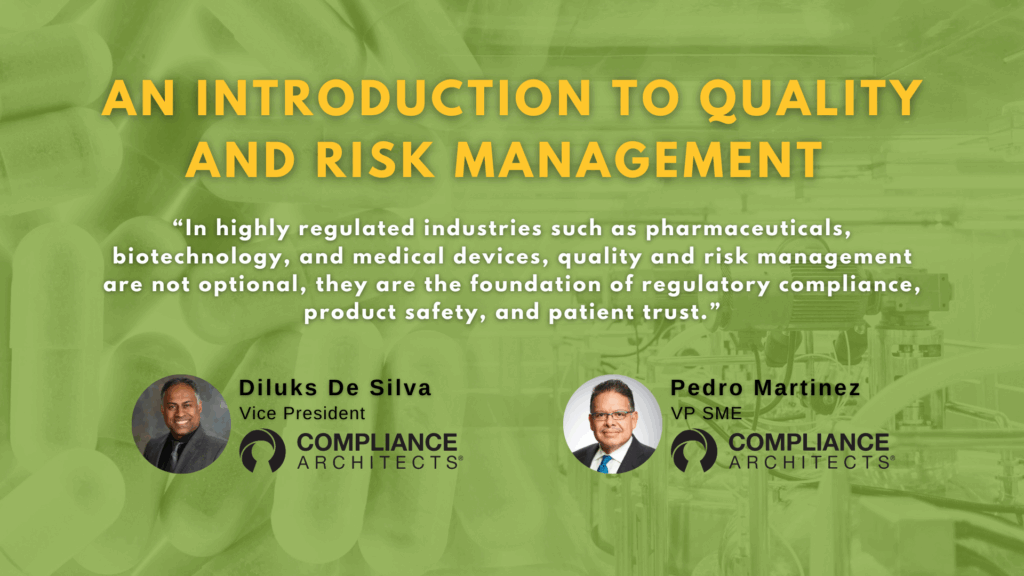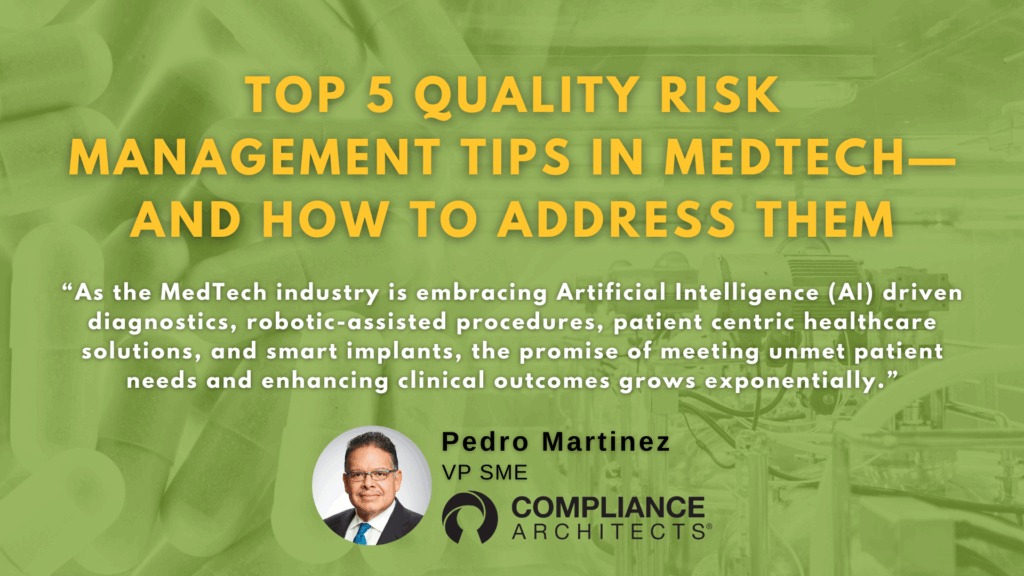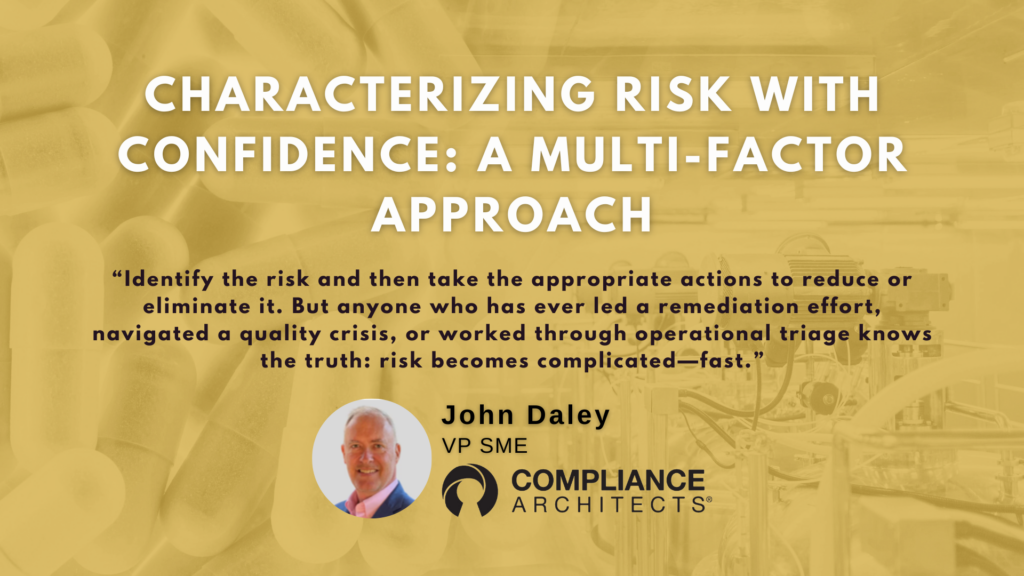
In highly regulated industries such as pharmaceuticals, biotechnology, and medical devices, quality and risk management are not optional; they are the foundation of regulatory compliance, product safety, and patient trust.
Risk management is a strategic discipline that focuses on proactively identifying potential hazards associated with medical devices, pharmaceuticals, and biotechnology products. It evaluates the severity and likelihood of their impact on patient safety, product performance, and regulatory compliance, and implements robust controls to prevent or mitigate these risks throughout the product lifecycle.
In the pharmaceutical, biotechnology, and medical device industries, this is not optional; it is required by regulations such as ICH Q9 for pharmaceuticals and ISO 14971 for medical devices and enforced by agencies like the U.S. FDA, EMA, and EU National Competent Authorities (for medical devices).
Risk management must be applied across the entire product lifecycle, from design and development to manufacturing, distribution, and post-market monitoring, to ensure patient safety, product quality, and compliance with Good Manufacturing Practices (GMP) and Quality System Regulations (QSR). By integrating risk management into daily operations, companies can detect and address issues early, protect patients and customers, and reduce the likelihood of costly compliance failures.
Global health authorities, such as the U.S. Food and Drug Administration (FDA) and the European Medicines Agency (EMA), as well as other regulatory bodies, have established clear expectations that organizations must adopt risk-based approaches to quality. This is evident in frameworks such as:
- ICH Q9 – Quality Risk Management (adopted by the FDA, EMA, and other International Council for Harmonization ( ICH) members.
- 21 CFR Parts 210, 211, and 820 (U.S. regulations for drugs and medical devices)
- EudraLex Volume 4, Annex 20 (EU GMP Guidelines – Quality Risk Management)
- ISO 13485:2016 and ISO 14971:2019 (International Standards for medical device QMS and risk management)
- ISO 9001:2015 (General quality management standard applicable across industries)
These frameworks are not merely checklists; they represent a philosophy of prevention, control, and continuous improvement.
Table of Contents
Understanding Quality and Risk Management
Quality Management
Quality management ensures that every process, system, and product consistently meet defined requirements. It serves as the foundation of regulatory compliance, providing the operational framework necessary for consistent, evidence-based decision-making.
This is accomplished through a structured Quality Management System (QMS) that encompasses the following elements: Policies, Standard Operating Procedures (SOPs), and work instructions.
- Defined roles, responsibilities, and authorities.
- Systems for document control, training, change management, and audit.
- Continuous monitoring and improvement processes.
Key Regulatory References
- 21 CFR Part 211 – Current Good Manufacturing Practice for Finished Pharmaceuticals.
- 21 CFR Part 820 – Quality System Regulation for Medical Devices.
- ISO 13485:2016 – Medical Devices QMS standard with a strong risk-based focus.
Risk Management

Risk management is the process of identifying, analyzing, controlling, and monitoring potential threats to product quality, patient safety, and regulatory compliance.
In regulated industries, risk is defined not only in terms of business impact, but also in terms of patient harm and regulatory consequences.
Key Regulatory References
- ICH Q9 – Quality Risk Management – Defines a systematic process for risk assessment, control, communication, and review.
- ISO 14971:2019 – Specifies the risk management process for medical devices, from hazard identification to post-market monitoring.
- EudraLex Volume 4, Annex 20 – Guidelines on Quality Risk Management (QRM) for Medicinal Products in the EU. It aligns with ICH Q9 for EU GMP compliance.
Why It Matters in Compliance
A single quality failure, such as an out-of-specification (OOS) result, deviation from a process, SOPs, and/or data integrity lapse, can have dire consequences:
- Patient Harm – Potential injury or loss of life, leading to ethical and legal consequences.
- Regulatory Action – FDA Warning Letters, EU GMP nonconformities, Loss of Market Licenses, or consent decrees.
- Product Recalls – Costly, damaging to brand reputation, and disruptive to supply chains.
Regulators increasingly expect risk-based decision-making. For example:
- FDA uses risk to prioritize inspections and compliance actions.
- EMA and EU National Competent Authorities require manufacturers to apply risk management principles to all aspects of GMP.
How to Mitigate Compliance Risk: A Detailed Approach
1. Establish Clear Governance and Accountability
- Define responsibilities for risk management in procedures, job descriptions, and organizational charts to ensure effective management.
- Ensure that management provides the necessary resources and leadership to ensure compliance.
- Reference: 21 CFR 820.20; ISO 13485:2016 Clause 5.
2. Identify and Assess Risks Early
- Use structured tools such as Failure Mode and Effects Analysis (FMEA), Hazard Analysis, or Fault Tree Analysis (FTA).
- Consider both operational risks (e.g., equipment breakdowns, supplier quality issues) and compliance risks (e.g., incomplete documentation, untrained personnel).
- Reference: ICH Q9 Sections 4 & 5; ISO 14971:2019 Clause 4.
3. Implement Robust Controls
- Implement preventive measures, including environmental monitoring, equipment qualification, and automated checks.
- Maintain detailed SOPs aligned with regulations and ensure they are current, controlled, and followed.
- Implement supplier qualification programs and contractual quality agreements.
- Reference: 21 CFR 211 Subparts C & D; EudraLex Volume 4 Part I Chapters 4–7.
4. Monitor and Measure Effectiveness
- Use Key Performance Indicators (KPIs) for quality (e.g., deviation/non-conformances closure time, audit finding trends).
- Conduct regular internal audits per ISO 9001/13485 and GMP requirements.
- Establish a Management Review process to evaluate QMS effectiveness and risk status. An effective Quality Management Review demands active leadership involvement!
- Reference: ISO 13485:2016 Clause 8.4; 21 CFR 820.100(a)(4).
5. Respond and Learn
- Investigate incidents using Root Cause Analysis (RCA) tools such as 5 Whys, Ishikawa Diagrams, Pareto, or Kepner-Tregoe.
- Develop Corrective and Preventive Actions (CAPAs) that are SMART (Specific, Measurable, Achievable, Relevant, Time-bound).
- Verify CAPA effectiveness before closure.
- Reference: 21 CFR 820.100; ICH Q9 Section 6.
6. Foster a Quality Culture
- Train employees not only on “how” but also on “why” procedures matter.
- Encourage trending and reporting of near misses without fear of retaliation.
- Recognize individuals and teams who identify and address risks proactively.
- Reference: EMA Q&A on GMP and Quality Culture; ICH Q10 Pharmaceutical Quality System.
Summary
Quality and risk management are more than regulatory requirements; they are strategic enablers of operational excellence, patient safety, and business continuity.
By embedding these practices into daily operations and grounding them in recognized frameworks, such as ICH Q9, ISO 13485, ISO 14971, 21 CFR Parts 211 and 820, and EudraLex Volume 4 Annex 20, organizations can proactively mitigate compliance risk and build lasting trust with regulators, customers, and patients.





